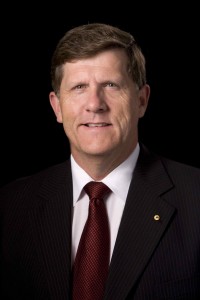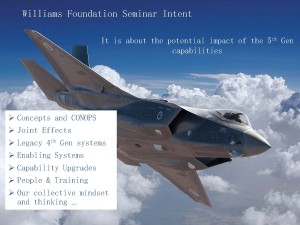2014-03-21 by Robbin Laird
After The Williams Foundation seminar, I sat down to discuss with one of the organizers of the seminar, Vice Air Marshall (Retired) John Blackburn his take on the questions, which posed to the seminar and how he thought those answers, were generated.
The core questions, which guided the seminar, can be seen in the slide below:
Question: You helped set up and host a conference at The Williams Foundation, which focused on the evolution of airpower in the decade ahead.
The RAAF is in the throes of a modernization process – C-17s, KC-30As, Wedgetail and F-35s. Could you talk about the goals of the conference and the way ahead for the RAAF?
Blackburn: What we sought to do was to open up people’s minds to the potential impact of the JSF as a transforming capability.
It’s a trigger for change.
There is a risk in a lot of organizations and in a lot of places of people thinking about this airplane is to replace a previous generation of airplanes. It is not.
What we’re trying to do is get people to understand that it’s not just the airplane. It’s the total system. It’s the transformation of the CONOPS capability.
It networks and links in far different way from many other previous generations, and it will enhance our existing fourth generation capabilities.
We are looking at integration across the force with platforms like the Super Hornets, the 4.5 generation, the Classic Hornets, but also our Wedgetail capability, our AEW&C platform which – frankly – is leading edge technology and software upgradable unlike any our other previous platforms.
In other words, the combination of JSF with its transforming capability with Wedgetail, which is a significantly changed capability from the past, and our legacy capabilities gives us the opportunity to actually transform our force rather than just evolve it.
Question: The RAAF Wedgetail squadron is already living the experience of operating a 21st century system with software upgradeable built in. This puts Australia on the cutting edge. How will this play into the coming of the F-35 in Australia?
Blackburn: I think what it does is it changes people’s mentality or approach.
In the old days you had to wait for almost a midlife upgrade.
You would operate it past 10 years. There’d be a lot of process and paperwork for midlife upgrade.
And with the Hornet, we did that
This is a different model now where we can use the software upgrade capability of these platforms and continually evolve them in concert with other capabilities.
It is not just upgrading something within the Wedgetail. Now we can focus on how we’re going to achieve an outcome.
And instead of waiting five years for the next upgrade, you get an idea, you can insert that into a software upgrade program.
In a simple sense, it is analogous with the iPhone. That next IOS that comes after the iPhone could significantly change the functionality of the particular platform.
It is the ability as well rapidly to adopt change and take advantage of not only the capabilities of one platform but multiple capabilities as well and this new approach is going to change our approach to combat.
Question: The operators of the F-22s and F-35s coupled with Col. Orr’s focus on the integration of fifth generation capabilities within the USMC total force concept of the MAGTF really was a highlight of the conference. They drove home the point that even that is a fifth generation aircraft, it is not simply a replacement for the past generation of combat aircraft, but part of a whole pattern of change in combat approaches. Does this make sense as the core point really of the conference?

Blackburn: Absolutely.
The message you got from those operators was this is not just to replace an airplane. This is a change in thinking. It’s a change in approach to operations.
The lessons that these young guys brought back out of it was striking because they were talking to an audience of operators, as well as, as a range of defense people in general.
The fact that the operators could get out there and say, this is what we learned from this experience. It’s not just we’re replacing our planes. It’s a change of thinking. It’s a change of doing things.
But also there is the opportunity by working not only within the RAAF context but with the Marines and other parts of the U.S. Forces, we can evolve and transform how we fight because we are jointly enabled by the JSF, fifth generation capability or the F-22.
That was the exciting part.
So we’re not listening to a company representative tell us that this is the best thing they’ve built. We’re not listening to sales people.
We’re listening to operators who’ve been through an experience that had fundamentally affected them. They get it. They’re driving change at their level.
So what we’re very keen in seminars to tell the audience of Air Force and people who are in there and the defense folks, it’s the opportunity they will have to take these capabilities, look at different ways to innovate and work with them. That is the exciting piece.
We don’t have to wait for a company to deliver the next upgrade. It’s how the operators use it and how they innovate it is going to make the difference.
Question: There were many younger officers from the RAAF in the audience. What do you think the message received was by these officers?
Blackburn: It is clearly a plane for their generation.
Leadership in this era of technological change is not about controlling from the top and directing everything.
It’s about enabling an environment of innovation and you let those younger generations experiment and develop and you give them the best space to work.
The older generation has a very important role. Experience is something that’s very hard won. You’ve got to guide mentally, these folks.
But what you can’t do is constrain them.
You set a vector where we’re trying to head and say, “Folks, go and have a look at this. You innovate. You think about what’s different here. You do it.”
However, throughout that process, don’t forget the experience is hard won. Let’s help them do that. Guide them. Don’t let them fall off the edge.
But give them a fair bit of free rein to try and do it. If we do that, that’s where our Western forces will maintain not only a technology edge but also a capability edge because it’s that ability to innovate very rapidly, to work out very different ways of doing things that our next generations will bring to the fight.
Question: The RAAF has significant combat experience in the past decade. How does this affect the innovation process?
Blackburn: And one of the, the clear implications talking to the RAAF is this is a battle-hardened force. These are people who have gone through war, multiple wars and are bringing that combat experience to the definition what to do with the aircraft.
In the past, we didn’t have a very broad depth in recent generations of combat experience. That’s changed in the last 10 years.
Our Australian Defense Forces have been in operations, significant operations. And now we have a much better way to relate to the U.S. Forces who have also been on an extended pace of high tempo operations.
Having the Marines come onboard in Australia is important as well. It’s really good to see how a truly a joint force is doing its job.
One of the challenges we’ll face in Australia is making sure that the Army, Air Force, and Navy work together in an even more integrated way to produce a better combat outcome.
And it’s one of the key challenges for the Air Force is going to be to communicate that the JSF it’s not just a shiny expensive airplane.
This is a transformation point, a trigger.
It can change the way not on the Air Force works but all the three services work together.
The Marines are a great example of working the different elements of a joint force.


